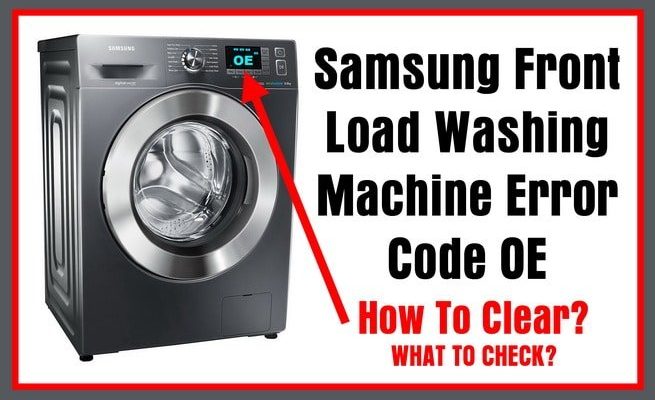
So, what exactly is this code telling you? In simple terms, the OE error code is your washing machine’s way of letting you know there’s a drainage problem. Think of it like when you try to fill up a bathtub but realize the drain plug is missing; no matter how much water you pour in, it’s just going to keep running out. In the case of your washing machine, the water isn’t draining as it should, and the machine can’t continue its cycle until the issue is resolved.
Understanding the OE Error Code
The first thing you might want to know about the OE error code is that it’s often linked to problems with water drainage. Imagine trying to empty a bucket of water through a straw—it’s not going to happen quickly, is it? Your Samsung washing machine might be experiencing something similar if the water isn’t draining properly. An obstructed drain hose, a clogged pump filter, or a stuck drain pump are common culprits.
Let’s delve a little deeper: the drain hose is the component that carries water out of the machine and into your home’s plumbing. If it’s kinked, blocked, or placed too high, water can’t flow out effectively, causing the OE error to pop up. Similarly, the pump filter, which catches lint and debris, can get clogged over time. If neglected, it becomes like a clogged vacuum cleaner bag—not very effective at doing its job. Lastly, the drain pump itself can sometimes fail or get obstructed, preventing the machine from draining properly.
Here’s the deal: while some of these issues can be resolved without professional help, sometimes the problem might persist or be more complex than a quick fix. That’s where calling a technician becomes necessary. But how do you know when it’s time to make that call? Let’s explore.
When You Can Fix It Yourself
Before reaching for the phone, there are a few things you can try at home. Picture it like a checklist that you go through when your car won’t start—check the battery, gas level, and other basics. For your washing machine, the first step is to inspect the drain hose. Make sure it’s positioned correctly, without any kinks or blockages. It’s like making sure a garden hose isn’t tangled when you’re trying to water the plants.
Next, check the pump filter. This involves a little bit of bravery, as you’ll need to open the filter access panel at the bottom of the machine—it’s like cleaning out the vacuum bag. Look for any debris or lint that might be clogging the filter and remove it. Tighten everything back up and give the machine another go to see if the error code disappears.
If your machine still isn’t working properly after these steps, it could be a sign that the issue is beyond basic troubleshooting. Fixing a drain pump or addressing electrical issues isn’t as straightforward as changing a lightbulb, which brings us to the next crucial part: knowing when to call in the pros.
When It’s Time to Call a Technician
While DIY fixes can be rewarding, there are times when calling a technician is the safest and most effective solution. Suppose your machine is still displaying the OE error after you’ve checked the hose and filter. In that case, the problem may lie with the drain pump or the internal electronics. Imagine it like trying to solve a Rubik’s cube blindfolded—frustrating and unlikely to be successful without specialized help.
Beyond personal frustration, continuing to run the machine with unresolved issues can lead to bigger problems or even damage your washing machine permanently. For instance, constantly resetting the machine can wear out other components, much like restarting a computer repeatedly might cause software glitches. A qualified technician has the tools and expertise to diagnose the issue accurately, ensuring your washing machine is fixed properly and promptly.
What’s more, seeking professional help might even be more economical in the long run. While it might seem tempting to save money by avoiding a service call, you could risk exacerbating the problem, leading to costly repairs or replacements. A technician’s insight can prevent such mishaps and give you peace of mind.
Preventative Tips for the Future
Now that you know when to call a technician for an OE error, let’s talk about how you can prevent this pesky problem from cropping up in the first place. Prevention is, after all, better than cure—a bit like brushing your teeth to avoid cavities rather than waiting until you need a filling.
Start by regularly cleaning the pump filter. It’s a simple but effective way to prevent blockages, much like cleaning out your lint trap after every load of laundry. Just make it part of your routine, perhaps once a month, to ensure that nothing is hindering your machine’s drainage capabilities.
Another useful tip is to keep an eye on what you’re putting in the wash. Too much lint or large objects can get trapped and cause blockages, similar to putting too many leaves in a garden waste bin, causing it to overflow. Consider using a laundry bag for smaller items like socks that could easily get sucked into the water drainage system.
Lastly, always ensure your machine is level and placed on a firm, even surface. An uneven machine can have trouble draining properly, just as an uneven table will wobble and cause things to spill.
In conclusion, while the OE error code can seem daunting at first, with a bit of know-how and some thoughtful preventative measures, you can keep your Samsung washing machine running smoothly and know exactly when it’s time to call in the experts.
